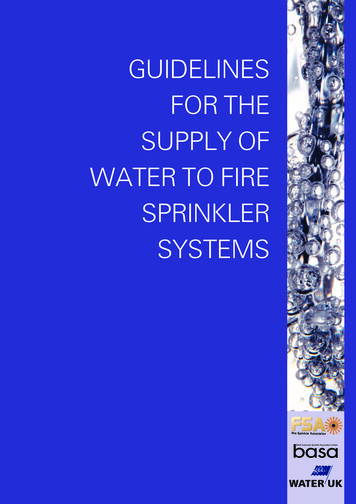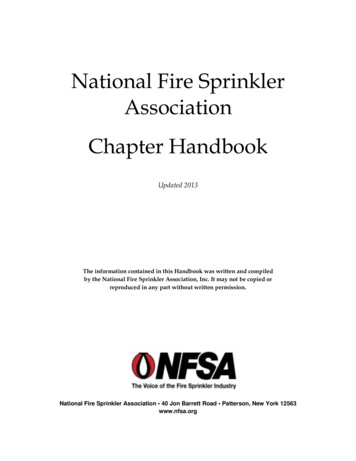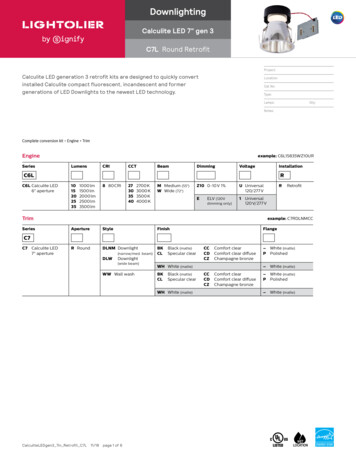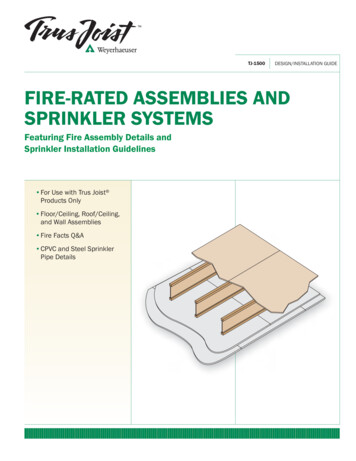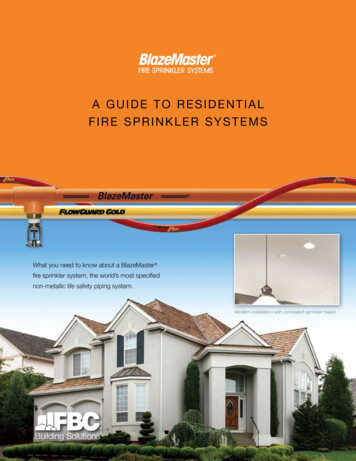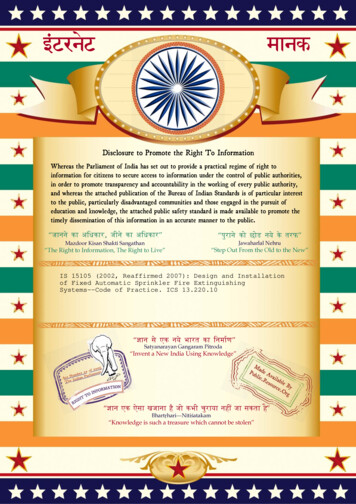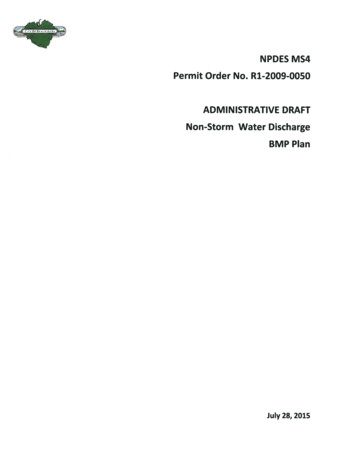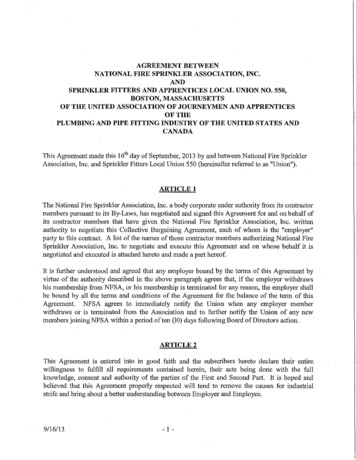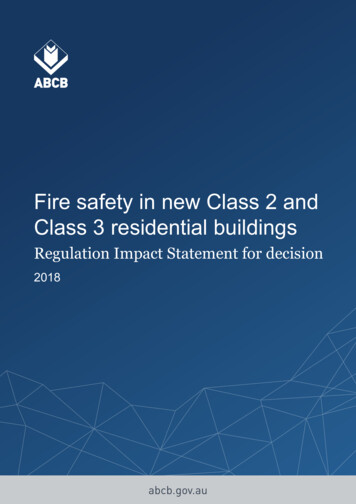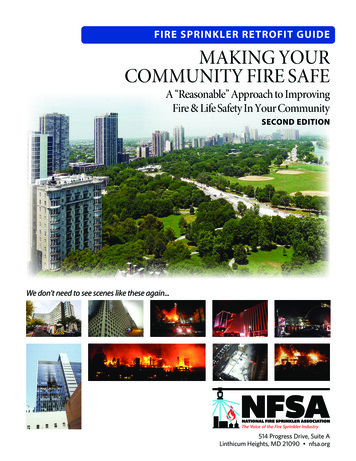
Transcription
FIRE SPRINKLER RETROFIT GUIDEMAKING YOURCOMMUNITY FIRE SAFEA “Reasonable” Approach to ImprovingFire & Life Safety In Your CommunitySECOND EDITIONWe don’t need to see scenes like these again.514 Progress Drive, Suite ALinthicum Heights, MD 21090 nfsa.org
FOREWORDThis document was originally published as Fire Sprinkler Retrofit –A Step-By-Step Approach for Communities. Jim Dalton, the Directorof Public Fire Protection for the National Fire Sprinkler Association(NFSA), developed it in 2006. In his acknowledgement section, henoted the assistance he received from other NFSA staff, specificallythe Director of Regional Operations, Buddy Dewar, and the NationalTraining Manager, John Corso. These gentlemen participated onthe development team and provided valuable input along the way.However, Jim gave the lion’s share of the credit for the original draftof the manuscript to Mr. Steve Hart, who at that time worked for theNational Automatic Sprinkler Industry Fund. In Jim’s words, “As apast local Fire Marshal and Deputy State Fire Marshal in California,Steve’s knowledge and experience in local and state fire protectionissues and initiatives made him the perfect choice to produce an initial draft for the team to work from and eventually produce this userfriendly guide.”As a result of the “Great Recession” that took place in the UnitedStates in the decade between the original publication of this document and the current revision, there have been fewer fire sprinklerretrofit programs especially at the municipal and state level. Nevertheless, fire sprinkler retrofit has continued with federal rulemakingthat requires the complete retrofit of the nation’s nursing homes.There is also continued voluntary efforts to retrofit student housingon college and university campuses. There are a number of individual municipal efforts to ensure that these initiatives happen. Optimistically, this update of the Retrofit Guide will encourage others to be avoice and move forward with the vision held by Jim Dalton a decadeago; moving toward a safer future through the retroactive installation of fire sprinkler systems.The new title Fire Sprinkler Retrofit Making Your CommunityFire Safe reflects a change in approach for the publication itself.Instead of simply recommending consideration of individual campaigns for fire sprinkler retrofit of the most dangerous occupanciessuch as high-rise buildings or nightclubs, this document contains arecommended option to address community fire safety as a whole,by urging the adoption of minimum fire sprinkler requirements forthe variety of existing occupancies for which there is already widespread agreement that retrofit is needed. Regardless of what buildingand fire codes have been adopted and enforced within a community this document recommends the adoption of the fire sprinklerrequirements for existing occupancies that have been recommendedthrough a consensus process and recognized by the AmericanNational Standards Institute. As such, these thresholds for firesprinkler retrofit represent minimum requirements for a reasonablelevel of protection. Citizens of every community deserve this level ofprotection; all that is needed are community leaders that can accomplish this a reality, and make their communities fire safe.National Fire Sprinkler AssociationMay 2017FIRE SPRINKLER RETROFIT GUIDE
TABLE OF CONTENTSIntroduction. . . . . . . . . . . . . . . . . . . . . . . . . . . . . . . . . . . . . . . . . . . . . . . . . . . . . . . . . . . . . . . . . . . . . . . . . . . . . . . . . . . . . . . . . .2The Last 50 Years – A Growing Appreciation for Fire Sprinklers . . . . . . . .3Statistics and Facts on Fires and Fire Sprinkler Performancein the United States . . . . . . . . . . . . . . . . . . . . . . . . . . . . . . . . . . . . . . . . . . . . . . . . . . . . . . . . . . . . . . . . . . . . . . . . . . . . . . .4The Special Role of Fire Sprinklers . . . . . . . . . . . . . . . . . . . . . . . . . . . . . . . . . . . . . . . . . . . . . . . . . . . . . . .4Part 1 – A Consensus Plan for SprinklerRetrofit . . . . . . . . . . . . . . . . . . . . . . . . . . . . . . . . . .7Part 2 – Targeted Plans for Sprinkler Retrofit . . . . . . . . . . . . . . . . . . . . . . . . . . . . . . . . . . . . 11Part 3 – Identifying Barriers to Retrofit . . . . . . . . . . . . . . . . . . . . . . . . . . . . . . . . . . . . . . . . . . . . .21Part 4 – Preparing the Necessary Documents . . . . . . . . . . . . . . . . . . . . . . . . . . . . . . . . . . . .31Part 5 – The Adoption Process . . . . . . . . . . . . . . . . . . . . . . . . . . . . . . . . . . . . . . . . . . . . . . . . . . . . . . . . . . .35Part 6 – Implementation and Customer Service . . . . . . . . . . . . . . . . . . . . . . . . . . . . . . . inghigh- ectiontocitizens,buildingowners,ndent. We have a list, however firefighters,as changes aremade atLLR, weandtheoverallcommunity.tructor/Training Coordinator II positions opening up and these erworldbyminimizingtheimpactnal development, design, resources.Carolina has a great fire serviceduring the past two years. gwithyoutoprotecteverythingin serving. Please have a safe and happy holiday season!fromhomestohigh- ‐‑rises tFIRE SPRINKLER RETROFIT GUIDEA – An Express ModelOrdinance for ConsensusSprinkler Retrofit . . . . . . . . . . . . 52B – Sample SprinklerRetrofit Ordinances . . . . . . . . . 54C – A Fire SprinklerContactors Perspective. . . . 57D – Websites forAdditional Resources . . . . . . 59Partners in Progress:National Fire SprinklerAssociation (NFSA), theInternational Associationof Fire Chiefs (IAFC)and the National FallenFirefighters Foundation(NFFF)Page 1
PARTNERS IN PROGRESSAugust 2017Dear Life Safety Advocate and Fire Service Community Leader:For over a decade, the National Fallen Firefighters Foundation has been working with an array of groupsand individuals in support of the installation of residential fire sprinklers and other Community RiskReduction Initiatives to make our neighborhoods safe from the ravages of fire. It is our firm belief thatwe can make a difference in reducing civilian and firefighter deaths and injuries because of theselifesaving initiatives.Specifically, we encourage every community to put forth the efforts necessary to enact fire sprinklerlegislation and retrofit actions by taking a stand for the safety and survivability of our neighbors andourselves. We continue to see the ever-changing dynamics of fire occurrence in today’s modern livingconditions and understand the need for the fast application of water to hold the spread of fire in checkuntil our personnel arrive on the scene, with everyone safely outside the structure awaiting our arrival.Through our combined efforts, we can make a difference. This was represented back in 2004 and 2014in Tampa Florida when our profession created and then reaffirmed the 16 Firefighter Life SafetyInitiatives and specifically Initiative #15: Advocacy must be strengthened for the enforcement of codesand the installation of home fire sprinklers. At both those gatherings our industry confirmed theimportance of residential fire sprinklers and the need to take appropriate steps to insure their installationnationwide, new and retrofit.The National Fallen Firefighters Foundation stands in support of these efforts and encourages the use ofthis retrofit guide as tool to assist you in making your communities a safer place to live, work and play.We applaud the National Fire Sprinkler Association and the International Association of Fire Chiefs fortheir involvement as we partner in support of the delivery of this vital resource document. Together wecan make a difference.Sincerely,Chief Ronald Jon SiarnickiExecutive Director16825 South Seton Avenue2130 Priest Bridge DrivePost Office Drawer 498Suite 6Emmitsburg, Maryland 21727Crofton, Maryland 21114410.721.6212 phone * 410.721.6213 fax301.447.1365 phone * 301.447.1645 faxwww.FireHero.org * FireHero@FireHero.orgPartners in Progress:National Fire Sprinkler Association (NFSA), theInternational Association of Fire Chiefs (IAFC) andthe National Fallen Firefighters Foundation (NFFF)Page 2FIRE SPRINKLER RETROFIT GUIDE
PARTNERS IN PROGRESSAugust 2017Dear Life Safety Advocate and IAFC Member:The role that fire sprinklers play in preventing fire deaths and conflagrations in our communities issignificant. While fire service leaders often focus on the justification and acquisition of physicalresources in their cities, the need to retrofit existing buildings with automatic fire sprinklers must alsobe at the top of our list of priorities. Fire sprinklers have an unprecedented history of being reliable andreducing the chance of catastrophe.The International Association of Fire Chiefs (IAFC) fully supports fire sprinkler retrofit initiatives.These initiatives not only translate into civilian lives saved, but also have a positive impact on the livesof firefighters. We, as fire service leaders, must examine local codes and ordinances and work to findopportunities to help retrofit existing buildings to reduce the risk to our communities. On the behalf ofthe 12,000 members of the IAFC, we challenge you to help with this critical safety effort by listening,learning, and taking action within your own jurisdiction.Making change in public safety can be difficult. However, it is through learning, collaboration, andbrave action that we can hope to actually make a difference. The IAFC is proud to work with theNational Fire Sprinkler Association on this crucial topic.In Service,Mark W. Light, CAEChief Executive Officer and Executive DirectorFire Chief Thomas C. Jenkins VPresident and Chairman of the BoardPartners in Progress:National Fire Sprinkler Association (NFSA), theInternational Association of Fire Chiefs (IAFC) andthe National Fallen Firefighters Foundation (NFFF)FIRE SPRINKLER RETROFIT GUIDEPage 3
INTRODUCTIONThis document, hereafter referred to as theRetrofit Guide, is intended to assist fire chiefs andother community leaders with implementing a firesprinkler retrofit program within their communities. The original National Fire Sprinkler Association (NFSA) Retrofit Guide began by directing thereader through a Fire Sprinkler Retrofit DecisionFlowchart, to help establish whether current State,Local laws, and/or Ordinances had been adoptedthat included fire sprinkler retrofit provisions. TheDecision Flow Chart was supported by a CodeMatrix developed to identify the various codesbuilding and/or fire, new and existing NationalFire Protection Association (NFPA) or International Code Council (ICC) and the respective codesections that already addressed retrofit provisionsof the various occupancy classifications. This flowchart is still useful today as a tool to help developprograms advocating retrofitting.The premise behind this approach was thatmany communities already have sprinkler retrofitrequirements enacted through code adoption, primarily the existing building provisions of the NFPA101 Life Safety Code. The Life Safety Code is developed by the Committee on Safety to Life, formedin the aftermath of the 1911 Triangle Shirtwaist firethat killed 146 workers in a New York City garmentfactory. Published for many years as the BuildingExits Code, the Life Safety Code is often adopted inaddition to building and fire codes. The NationalFire Protection Association, which promulgates thecode, reports that it is currently used in every state,and adopted statewide in 43 states. Yet the provisions for existing buildings are often not enforced,among which are fire sprinkler retrofit provisions.This Retrofit Guide still follows that process inPart 2, however Part 1 encourages a faster morecomprehensive effort to recognize and publicizethe need for fire sprinklers in buildings wherethey are absolutely needed and encouraging community leaders to enact specific rules to bringabout an orderly program of compliance. Thisdocument assumes that even if the NFPA 101 LifeSafety Code has been legally adopted at somepoint in the past, it has not to date been rigorouslyenforced. Therefore, it encourages the adoption ofthe sprinkler retrofit provisions of that documentas a new ordinance, with full public review, adoption, and enforcement within a reasonable timeframe for compliance.FIRE SPRINKLER RETROFIT DECISION FLOW CHARTIdentifyOccupancy(Part I)Conduct CodeAnalysis(Part II)Is anApplicableCodeAdopted?YESEnforceCode(Part IV)NOPursue CodeAdoption(Part IV)Page 4IdentifyBarriers(Part III)PursueLegislativeMandate(Part IV)Adopt Code(Part V)Adopt Mandate(Part V)Enforce Code(Part VI)Enforce Mandate(Part VI)FIRE SPRINKLER RETROFIT GUIDE
THE LAST 50 YEARSTHE LAST 50 YEARS A GROWING APPRECIATION FOR FIRE SPRINKLERSIn March of 1968, the United States Congresspassed Public Law 90-259 – The Fire Research andSafety Act of 1968 which, among other elements,authorized directly or through contracts andgrants, “research into the causes and nature of fires,and the development of improved methods and techniques for fire prevention, fire control, and reductionof death, personal injury, and property damage.” 1The law also created the National Commission on Fire Prevention and Control, which wasdirected “to undertake a comprehensive study andinvestigation to determine practicable and effectivemeasures for reducing the destructive effects of firethroughout the country.” 2On May 4, 1973 the National Commission onFire Prevention and Control issued its comprehensive report “AMERICA BURNING,” whichoutlined the nation’s fire problem, addressing fireand the building environment, the fire service andfire prevention efforts, and programs for the future.Among the Commission’s recommendations wasthat “the proposed U.S. Fire Administration support the development of the necessary technologyfor improved automatic extinguishing systems thatwould find ready acceptance by Americans in allkinds of dwelling units.” 3The recommendations led to federal funding ofresearch and by the1980s culminated in the development of residential and quick response sprinklers, which have now effectively replaced oldertechnology fire sprinklers intended only for property protection. The improved technology has ledto improved performance. As a result, fire sprinklersystems are now required throughout the countryin almost all-new construction. A growing numberof communities and at least two states, Californiaand Maryland, additionally require sprinkler protection of all new single-family homes.In the summer of 1999, the Director of the Federal Emergency Management Agency (FEMA)formally re-commissioned a Blue Ribbon Panelof experts to assess the progress related to theconcerns raised in the “America Burning” reportcreated more than twenty-six years earlier. Thisnew panel of experts developed an updated report“AMERICA BURNING RECOMMISSIONED–AMERICA AT RISK” which formulated its conclusions as “Findings and Recommendations.” OnMay 3,2000, the report was issued, with a subsequent publication date of October 2000.FIRE SPRINKLER RETROFIT GUIDEWhile Finding No. 1 addressed implementation ofloss prevention strategies, the second finding directlyaddressed the need for fire sprinkler systems.4Finding No. 2 – The Application and Use ofSprinkler TechnologyThe most effective fire loss prevention and reduction measure with respect to both life and property is the installation and maintenance of firesprinklers. If the focus is limited to preventionand reduction of the loss of life, smoke alarmsare also extremely effective. However, the use ofsprinklers and smoke alarms has not been sufficiently comprehensive.RECOMMENDATIONS:FEMA/USFA should develop a long-term implementation strategy for fire sprinklers and smokealarms. The plan should include the followingimplementation aspects: The approach should be community based; No tactic or strategy should detract from therequirement for sprinklers. Smoke alarms (orother measures) should always be the locality’ssecond option as a loss reduction measure; Exploration of the technical, economical andpractical aspects of utilizing smoke alarms andsprinkler systems that provide automatic notification to a firehouse. These systems should beprofessionally maintained and monitored; Confirmation of the accuracy of the belief thatthe appropriateness of the emplacement of sprinklers and smoke alarms may be based on ruraland urban distinctions, and whether other distinctions such as residential construction, commercial construction and critical facilities mayalso be appropriate; The plan should distinguish between requirements for new construction and existing construction.1Title-1 of Public Law 90-2592Title-II of Public Law 90-2593Op. Cit. p. 1204America Burning Recommissioned – America at Risk,Federal Emergency Management Agency, May 2000.Page 5
STATISTICS AND FACTS / SPECIAL ROLE OF FIRE SPRINKLERSSTATISTICS AND FACTSON FIRES AND FIRE SPRINKLERPERFORMANCE IN THEUNITED STATESBased on national fire incident reporting, theNational Fire Protection Association (NFPA) hasestimated that there were 1,345,500 fires in theUnited States during 2015, an increase of 3.7%from 2014.5 This meant that a fire department wasresponding to a fire somewhere in the United Stateson an average of every 23 seconds. These fires werereported to have resulted in total of 3,280 civilianfire deaths, 15,700 civilian injuries, and 14.3 billion in property damage. Of these fires, more thanhalf a million were structure fires.It is widely acknowledged that fire sprinkler systems have helped reduce these losses over the pastfew decades, and could reduce them even further.In addition to statistics regarding fires, theNFPA has compiled statistics on the performanceof automatic fire sprinkler systems,6 and has concluded that they are “highly reliable and effectiveelements of total system designs for fire protectionin buildings” that “save lives and property, producing large reductions in the number of deathsper thousand fires, in average direct propertydamage per fire, and especially in the likelihood ofa fire with large loss of life or large property loss.”While modern building codes require the installation of automatic sprinklers in almost all newconstruction of size, there have been many buildings constructed over the years without sprinklerprotection. The NFPA sprinkler performancereport stated that, based on fire department data forthe years 2007 to 2011, sprinkler systems were present in only 10 percent of reported structure fires.Because of their potential to reduce fire loss,many communities have enacted fire sprinklerretrofit requirements, especially for the occupancies that, based on past experience, present thegreatest risks to civilians. In many cases, the communities have addressed multiple occupancies atthe same time by adopting a code that containsoccupancy-based requirements for sprinklerretrofit. As stated previously, this Retrofit Guideenvisions a dual approach that essentially overlaysthe code-based consensus provisions for sprinklerretrofit through the adoption of a special ordinance. In this manner there can be a clear understanding of the need and plan for implementationthat simultaneously applies to all dangerous existing occupancies in need of fire sprinkler retrofit.5Haynes, Hylton J.G., “Fire Loss in the United States During2015,” National Fire Protection Association, September 2016.6Hall, John R. Jr., “U.S. Experience with Sprinklers, “ NationalFire Protection Association, June 2013.Page 6THE SPECIAL ROLEOF FIRE SPRINKLERSWhile fire protection provisions in building andfire codes deal with a great many items in additionto fire sprinkler systems, it should be recognizedthat these systems are unique. These systems havethe ability to make up for a wide range of other fireprotection deficiencies by addressing the fire whileit is still contained, and controlling or extinguishingthe fire before it can grow into a major threat to lifeand property.Nowhere can this be better seen than in the FireSafety Concepts Tree, originally developed as a logictree in 1973 and today contained within NFPA550– Guide to the Fire Safety Concepts Tree. Incombination, Figures 4.3 and 4.5.1 of the 2017 edition of this document shows how a fire sprinklersystem that both detects fire and applies sufficientsuppressant satisfies the “and” gate to suppress thefire. From that point upward there are only “or”gates to reach the Fire Safety Objective. In otherwords, a properly designed, installed and maintained fire sprinkler system provides fire safety, andcan overcome a failure to prevent fires or other fireprotection deficiencies.FIRE SAFETYOBJECTIVE(S) gefireimpact eManageexposed See Figure re byconstructionSee Figure 4.5.1LimitamountexposedSafeguardexposedSee Figure 4.5.2.1Figure 4.3 Top Gates of the Fire Safety Concepts Tree with Selected LowerTiered Gates (Figures 2016 NFPA. Used with permission.)FIRE SPRINKLER RETROFIT GUIDE
SPECIAL ROLE OF FIRE SPRINKLERSOne Meridian PlazaPhiladelphia, PennsylvaniaFebruary 23, 1991Managefire olfire byconstruction ControlfuelControl theenviromentControlmovementof fire sicalproperties ofenvironmentControlchemicalcomposition stabilityConfine/containfire AutomaticallysuppressfireManuallysuppressfire nicatesignalDecideactionRespondto siteApplysufficentsuppressantFigure 4.5.1 “Manage Fire” Branch of Fire Safety Concepts Tree.(Figures 2016 NFPA. Used with permission.)FIRE SPRINKLER RETROFIT GUIDEPage 7
SPECIAL ROLE OF FIRE SPRINKLERSGrenfell TowerLondon, EnglandJune 14, 2017Page 8FIRE SPRINKLER RETROFIT GUIDE
A CONSENSUS PLAN FOR SPRINKLER RETROFIT – PART 1PART – ACONSENSUS PLANFOR SPRINKLERRETROFITThe fire sprinkler requirements for existing buildings, like other requirementswithin the NFPA 101 Life Safety Code , were developed under a consensusprocess recognized by the American National Standards Institute (ANSI). Thebasic provisions have been in place for decades, although they are continually examined and modified in the light of new fire data and experience. Forexample, the requirements for fire sprinklers in existing nightclub occupancieswere strengthened in the aftermath of the 2003 Station Nightclub fire in WestWarwick, Rhode Island, that killed 100 individuals and left many others withsevere injuries. But because sprinkler retrofit provisions can be considered the“national standard,” their adoption can be considered an “express plan” for firesprinkler retrofit. In other words, there is widespread agreement that certainoccupancies identified by size and configuration are inherently unsafe withoutthe benefit of automatic fire sprinkler systems. Virtually all of the multiplecasualties due to fires that have taken place over the past century have been inbuildings contained in the previously mentioned categories.The Life Safety Code is certainly not the only code that requires sprinklerprotection of existing occupancies. For example, the International Fire Code,promulgated by the International Code Council, now also contains fire sprinkler requirements for existing nightclubs. However, the Life Safety Code firesprinkler requirements address a wide range of occupancies, and have beendeveloped by multiple technical committees, each of which includes experts inthe particular occupancy area. These experts, including user groups, fire officials, engineers, insurance authorities, and others, have carefully studied theiroccupancy characteristics over a long period of time, and have come to recognize when the benefits of fire sprinkler systems are absolutely needed.FIRE SPRINKLER RETROFIT GUIDEPage 9
A CONSENSUS PLAN FOR SPRINKLER RETROFIT – PART 1Once these technical committees agree on minimum requirements for a reasonable level of protection for their occupancy groups, a process thatincludes multiple opportunities for public inputand focus groups, as well as provisions that are codified into the language of the new edition of the LifeSafety Code. The fact that the code is recognizedas a national standard by the ANSI means that theprocess under which it was developed is consideredto be a legitimate consensus process. ANSI will onlyrecognize one document within a given subject areaas the national standard meanwhile giving NFPA101 a special status with regard to its provisions.For this reason, the Life Safety Code is recognizedand utilized by numerous federal governmentagencies, including the Department of VeteransAffairs and the Centers for Medicare and MedicaidServices.As stated in the Introduction, the Life SafetyCode addresses a wide range of building exit andother fire protection issues, but the intent of thisRetrofit Guide is to encourage only the adoption offire sprinkler retrofit provisions as a special overlay,recognizing that fire sprinklers can make up fornumerous other fire protection deficiencies andensure mitigation of loss due to fire. To date, thereis no known incidence of a multiple loss of life ofbuilding occupants due to a fire originating ina building protected with a properly designed,installed and maintained automatic fire sprinklersystem. It is no surprise that existing occupanciesthat are in most need of fire sprinkler protection arethose in which multiple life loss fires continue totake place in the absence of fire sprinklers.The following are the summarized requirementsfor fire sprinklers in existing occupancies as contained in the 2015 edition of the NFPA 101 LifeSafety Code, approved as the American NationalStandard on September 3, 2014.RETROFIT IN THE IFC, IBC AND THE IEBCThe International Building Code (IBC), International Fire Code (IFC) and the International Existing Building Code (IEBC) can apply to existingbuildings depending on triggers. These triggers aregenerally tripped when work is being done on thebuilding. The 2015 IFC does, in Chapter 11, haveseveral areas where active fire protection is requiredto be retrofitted in existing buildings:Page 10Fire Sprinklers I-2 occupancies, such as hospitals and nursinghomes, shall be retrofitted with sprinklers inall existing I-2 fire areas, throughout the floorscontaining the I-2 fire area and on all intervening floors to the level of exit discharge. I-2 Condition 2 occupancies (facilities thatprovide nursing, medical care and provide surgery, emergency care, obstetrics or in-patientstabilization) shall be retrofitted throughoutthe building with sprinklers by a separate ordinance. Cellulose nitrate file and pyroxylin plasticsmanufacturing, storage or handling requiressprinklers throughout. The 2018 IFC will require A-2 occupancieswith fire areas having more than 300 occupants consuming alcohol to retrofit with sprinklers. This requirement is not a blanket A-2retrofit, but only those A-2 fire areas wherealcohol is consumed that exceed 300 occupants will require fire sprinklers.Standpipes Buildings with occupied floors more than 50feet above (or below) the nearest level of firedepartment access are required to retrofit withstandpipes. Buildings with existing helistops or heliportsthat are over 30 feet above the lowest level offire department access shall be retrofitted withstandpipes.The IBC is primarily for new construction andrequires fire sprinklers in several occupancies andgenerally where the highest floor of the buildingexceeds 55 feet from the lowest level of fire department access. The IEBC code is to provide alternative approaches to remodeling, repair, additions,alterations, renovations, or change of occupancy ofexisting buildings. This code allows for maintainingbasic levels for fire prevention, structural and lifesafety features while controlling design decisionsand costs.The IEBC provides three main options for theuser in dealing with rehabilitation of existing buildings. The options are better described as paths ofcompliance for the architect. Once a path is chosen,the IEBC narrows down the rules for compliance.Regardless of the path chosen, fire protectionupgrades or retrofit is generally limited to the areaor floor where the work is being performed.FIRE SPRINKLER RETROFIT GUIDE
A CONSENSUS PLAN FOR SPRINKLER RETROFIT – PART 1ASSEMBLY OCCUPANCIES Where the occupant load exceeds 100 in the following assembly occupancies: dance halls, discotheques, nightclubs, and assembly occupancieswith festival seating. Coming up in the 2018 IFC: The 2018 IFC willrequire A-2 occupancies with fire areas havingmore than 300 occupants consuming alcohol toretrof
National Automatic Sprinkler Industry Fund. In Jim's words, "As a past local Fire Marshal and Deputy State Fire Marshal in California, Steve's knowledge and experience in local and state fire protection issues and initiatives made him the perfect choice to produce an ini - tial dra for the team to work from and eventually produce this user friendly guide." As a result of the .
